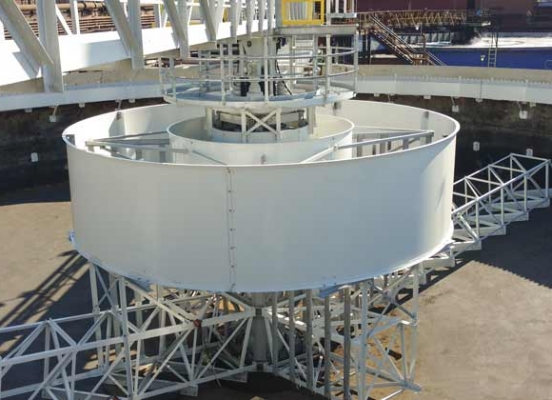Importance of Side Water Depth in Planning and Evaluating Clarification Equipment
Side Water Depth (SWD) is critical when the design engineer is planning new clarification equipment or evaluating existing units. Side water depth/sidewall depth is the depth of the water at the wall of the basin.
The application of the clarifier/settling tank has a lot to do with the selection of the side water depth. For a grit collector where the material acts according to Stokes Law, the side water depth can be fairly shallow. With waste treatment primary units, the side water depth is determined by holding solids inventory. In chemical clarifiers, solids inventory and detention time for flocculation and separation might be the basis of determining the side water depth. For water treatment units, the same parameters as chemical clarifiers/settling tanks are used. All of these parameters are site-specific as well.
The following is a discussion based on waste activated sludge final clarifiers. There appears to be more of an art to the design than just following a set of scientific guidelines with respect to SWD.
Waste Activated Sludge Final Clarifiers/Settling Basins
Much has been written on the design parameters to be used for final clarifiers, such as overflow rate, detention time, mass loading, settling velocity, etc. Unfortunately, not much has been written about SWD and its effect on clarifier performance.
It is common practice to design and evaluate a clarifier based on surface overflow rate and mass loading. In the past, detention time was used in selecting the depth of the clarifier. Current practices involve selecting the side water depth independent of detention time. However, little or no hard data has been generated on the effects that side water depth has on the performance of final clarifiers. This is probably due to the theoretical nature of the items to be considered.
Sufficient Depth for Efficient Operation
A clarifier should have sufficient depth to handle the transportation and solids inventory required for efficient operation. If the solids-holding depth is not adequate, the gross carry-over of the solids into the effluent can result, thus reducing the effluent quality. The question then arises: Will the clarifier needs additional depth to handle additional mixed liquor suspended solids (MLSS)? With this consideration, it would appear the side water depth should be selected on the basis of both required sludge detention time and the need to handle the above additional mixed liquor suspended solids.
The need for the correct design depth of the clarifier is made clear by examining the different settling zones (which have different settling characteristics) created by waste activated mixed liquor. These various zones as stated by Eckenfelder and Ford (starting at the top of the basin) are:
- Clarified water zone
- Individual particle zone
- Hindered zone
- Transition zone
- Compression zone
- Alternate concentration zone
The top and bottom zones are the most critical for final clarifiers. The bottom concentration zone is affected by the removal device and the mass loading. The top clarified zone is affected by the type of inlet and overflow rate. Since the main purpose of a final clarifier is to have ultimate clarification of the treated sewage, these zones should be looked at most critically.
To know more, please check Monroe Environmental.

